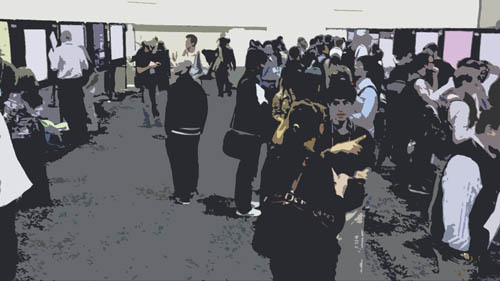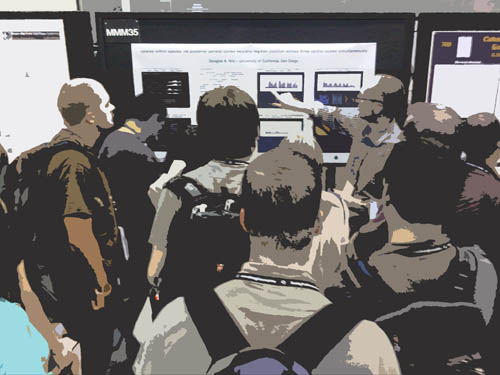Some final observations at the 2010 Society for Neuroscience meeting.
Presentations. 1. Yet another poster from the Frankland lab. I’m not sure that it’s surprising but certainly elegant and essential work. It’s known that hippocampal lesions can more reliably produce retrograde memory deficits than anterograde memory deficits. This is because in the normal brain a hippocampal strategy often dominates and therefore damage occurring after learning will structurally destroy the memory. In contrast, post-damage learning can be relatively spared because other brain structures can compensate. This study tested whether adult-born neurons play a similar role in learning by using mice with diptheria toxin receptors specifically expressed in adult-born neurons. This allowed them to kill new neurons either before or after training in discriminative fear conditioning and water maze tasks. Consistent with the general hippocampal story described above it was only when the neurons were killed after learning that memory was degraded. 2. The environment-specific new neuron activation story was interesting but is still a work in progress. Basically, it appears that if enriched environment #1 enhances survival of new neurons during their immature stage then only that environment (and not a different enriched environment #2) is capable of activating those neurons when they’re mature. The problem was that the enriched environment #2 was not capable of enhancing new neuron survival (which is in itself kind of interesting – they speculated that because it was very open, with no hiding places, it may have been stressful) and so it also may not be as capable of activating new neurons. Apparently they’re testing different enriched environments to determine which types enhance neuronal survival. Once they get 2 environments that are equally capable of enhancing survival, it will be interesting to see the extent to which neuronal activation is specific to the environment that the new neurons experienced previously. 3. Lastly a bit of neuroendocrine anatomy was interesting to me – people have long wondered how the hippocampus could be modulating the endocrine stress response. The hippocampus has many glucocorticoid receptors and lesions of the hippocampus increase circulating glucocorticoids but the circuitry needed to regulate the HPA axis has never been clear. This poster used lesions, tracer experiments and immediate-early gene imaging and concludes that multiple higher-order regions of the brain (mPFC and hippocampus) converge on the Bed Nucleus of the Stria Terminalis, which then exerts inhibitory control over the HPA axis.
Blogosphere. Being selected as an official neuroblogger more than doubled the traffic to Functional Neurogenesis over the last couple weeks. Most of the SFN neurobloggers got a passing grade here (phew). Some interesting discussion there about whether writing about science could be a waste of time inasmuch as it takes away from experiments / papers / funding. Interesting in that I’m surprised it could be so frowned upon (fortunately, I’ve never been the victim of such frowning).
And now for the final day of Photos of Popular Posters!
Whereas I have previously focussed only on popular posters, here I found an aisle imbalance:

Many people were interested in Learning and Memory: Physiology (right) but Modulation of Fear/Aversive Learning and Memory (left) appears to be a topic that SFN could eliminate for SFN 2011. Zeroing in on the hotness of the above scene I found that:
 Spaces within spaces: Rat posterior parietal cortex neurons register position across three spatial scales simultaneously by Doug Nitz was getting all the attention. More attention than any of the other PPP winners and so it gets dubbed the SFN2010 most popular poster. In fact, I might have put this presentation in my itinerary had I come across it in the online abstracts so, take home message: always be sure to crowd around the already-crowded posters.
Spaces within spaces: Rat posterior parietal cortex neurons register position across three spatial scales simultaneously by Doug Nitz was getting all the attention. More attention than any of the other PPP winners and so it gets dubbed the SFN2010 most popular poster. In fact, I might have put this presentation in my itinerary had I come across it in the online abstracts so, take home message: always be sure to crowd around the already-crowded posters.